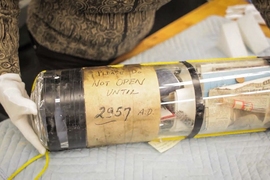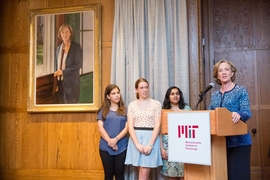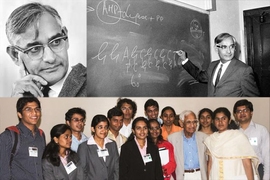At the height of World War II, an unlikely group of scientific heroes travelled from Britain to the United States by way of Canada, clinging tightly to Britain’s most prized scientific war-time secret: the cavity magnetron. This mission – known now as the Tizard Mission – began with the simple goal of mass producing the cavity magnetron, the core technology for microwave radar, on American soil. But, more importantly, it served as a catalyst for ending the war and beginning a long-lasting international collaboration between the United States, Great Britain, and Canada. It also led directly to the formation of the famed Radiation Laboratory (“Rad Lab”) at MIT, as well as to MIT’s emergence as a major federally supported research university.
This month marks the 75th anniversary of the Tizard Mission, and while it is often overlooked in the history books, its influence can still be seen today. The mission set the foundation for technology-sharing at institutions including NASA and the North Atlantic Treaty Organization (NATO); paved the way for future advancements including the jet engine and aircraft navigation systems; and solidified the continued need for collaborative scientific research through the implementation of research and development labs, including the Rad Lab’s direct descendants at MIT, the Research Lab of Electronics (RLE) and MIT Lincoln Laboratory.
In celebration of this anniversary, the three countries held a symposium at the Canadian Embassy in Washington on Nov. 17. Professor Yoel Fink, director of RLE, represented MIT at the event, which boasted members from the science, engineering, and development fields, in addition to military dignitaries. Throughout the day, panels and speakers noted the importance of the Tizard Mission to modern technology and reaffirmed their commitment to collaboration during times of peace and war.
"The Tizard Mission, and the partnership resulting from it, showed that the way we develop technology is just as important as how we use technology," said Vernon Gibson, chief scientific advisor for the United Kingdom's Ministry of Defense. "Tizard’s Mission was a desperate act of trust that sowed the seeds for future victory and collaboration."
The Tizard Mission: A brief history
In 1940, Great Britain was overwhelmed by the increasing power of Nazi German forces, facing nightly attacks from the Luftwaffe and rapidly diminishing resources. Following the advice of Sir Henry Tizard — a scientist who had played a critical role in creating Britain’s first radar defense system in the 1930s — British Prime Minister Winston Churchill commissioned a small task force comprising of both civilian and military scientists to travel to the U.S. to facilitate a technology exchange among the U.S., Great Britain, and Canada. Churchill and Tizard hoped that sharing the cavity magnetron — a vacuum tube that generates radar microwaves which was small enough it could fit in an aircraft — would spur an agreement for its production at scale on U.S. soil.
After travelling to the U.S. in secret during the fall of that year, the task force met with renowned scientists including Vannevar Bush, then science advisor to U.S. President Franklin D. Roosevelt; Alfred Loomis, a wealthy investment banker-turned-physicist; and MIT President Karl Compton. After a meeting at the Wardman Park Hotel in Washington hosted by Loomis, who chaired Bush’s “Microwave Committee,” the British disclosed the secret of the cavity magnetron. The American and British scientists agreed to collaborate, expanding the magnetron’s capabilities and designing other technologies, such as the proximity fuse, which would also be used during the war.
“The cavity magnetron allowed the miniaturization of radar, tipping the balance against U boats in the battle in the Atlantic,” said John Holdren, director of the White House Office of Science and Technology Policy and assistant to President Barack Obama for science and technology. “It also led to the proximity fuse, enabling precision of anti-aircraft fire and dramatically reducing the threat posed by Japanese planes to allied ships in the Pacific; the design of Whittle’s jet engine; and somewhat less well-known countermeasures against German radar. I think anyone who has studied the Second World War understands the Allied edge in many of these technologies played in the outcome [of the war].”
The creation of MIT's "Rad Lab"
To expand their research and begin production of the magnetron, scientists concluded they would need a facility large enough to house the project. With initial financing provided by Alfred Loomis, and with the support of the U.S. National Defense Research Committee (NDRC), the team opened the Radiation Laboratory under MIT’s governance at the end of 1940, using the then esoteric term 'radiation' as a cover for their work in radar.
At the peak of its service, the Rad Lab employed more than 4,000 people from all areas of academia, industry, and government — an approach in which much cross-sector research collaboration would be modeled after in the future. Throughout the war, the work of the Rad Lab would expand to include crucial technologies including microwave radar detection and long-range navigation systems — work ultimately helping turn the tide in favor of the Allies.
“The application of significant federal resources enabled research, development, and production of military technology such as radar, proximity fuse, and ultimately the atomic bomb; so many of these technologies came with great boost from our friends in the Tizard Mission,” Gibson said. “This was not only significant to the outcome of the war; it completely changed the status of science and technology in America and the role of scientists and engineers in advising the federal government. It helped set the stage for this country’s post-war economic success.”
In December 1945, as the war ended, the Rad Lab shuttered its doors, leaving many of its projects unfinished. The following year, the U.S. Office of Scientific Research and Development — an organization created by President Roosevelt on the urging of Vannevar Bush to oversee wartime science — sponsored the creation of MIT’s Research Laboratory of Electronics. The RLE utilized much of the same equipment and designs left by the Rad Lab, even continuing the development of microwave frequencies while expanding into many other engineering applications.
In the years that followed, because of the successes of both the Rad Lab and the RLE, the U.S. government continued to tap MIT to provide leadership and guidance on defense science efforts. Upon the explosion of the first Soviet atomic bomb in 1951, the U.S. found itself ill-prepared for the threat of an air attack and pursued a detection system using advanced electronics and early computing. The project, called SAGE, became the first assignment for MIT’s Lincoln Laboratory, further solidifying the Institute's role as a leader in federal research and development projects and a premiere research university.
Today, the presence of the Tizard Mission can be felt throughout the campus at MIT — from the RLE Lab, the Rad Lab’s direct descendent, to the Lincoln Laboratory, where federally funded research initiated by the Tizard Mission continues to serve as an integral part to the advancement of modern-day technology. In a larger sense, this marked the advent of the federally-funded research university, as well as the model for the federally-funded research and development center — the standard, collaborative way the federal government approaches R&D support today.
Commemorating the 75th anniversary of the Tizard Mission
The commemorative event at the Canadian Embassy convened panels nd speakers including His Excellency Gary Doer, ambassador of Canada to the United States; the Honorable Sean Stackley, assistant secretary of the U.S. Navy; and Rear Admiral Mathias Winter, chief of naval research, among many others.
Each panel and speaker noted the historical significance of the Tizard Mission and its many influences. The symposium concluded with all three countries signing a declaration, reaffirming their commitment to lateral and multilateral cooperation.
“What followed the Tizard Mission were developments in radar and aircraft engines, synthetic rubber, and nuclear research, all which contributed to final victory in the war,” Stackley said. “Equally, or more important than what followed in the course of these past 75 years — from winning the Cold War to today’s struggle against terrorism — the trust and cooperation and mutual respect that was sparked by that first encounter by those giants of science has continued to grow and to this day underpins that storied relationship we enjoy and with that, the strategic alliances we so greatly rely upon.”
Videos from the event can be found here.










